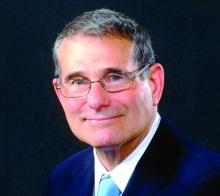A muddied field
S. Vincent Rajkumar, MD, a hematologist-oncologist and active researcher at the Mayo Clinic in Rochester, agrees. “Being on the board of directors of a pharmaceutical company, particularly by institutional leaders, is one of the genuine COIs” amid a field of COI that’s become increasingly muddied with the shift toward more comprehensive, general disclosure practices.
“It’s important that we don’t lose sight of clarity in what types of financial ties and relationships we’re really concerned about,” he said. “The ties that are really concerning – the significant conflicts of interest – are serving on boards of companies or getting large personal payments for participating in speakers’ bureaus or single, company-sponsored CME lectures, for instance, or having stocks, investments, or significant royalties or large payments to your lab or research program [outside of clinical trial funding].”
Other financial transactions such as “reasonable” payments for participation in data-monitoring committees and steering committees are financial ties that should be disclosed, but generally aren’t concerning, Dr. Rajkumar said.
Dr. Rajkumar serves as an editor-in-chief of the Blood Cancer Journal and is an author of several UptoDate chapters. Because of these roles and in keeping with his own views on COI, he has worked deliberately over the past decade to be free of industry payments.
This has become increasingly difficult given the breadth of payments attributed to individual physicians on the federal Open Payments website – some of which are “not truly personal financial ties.” He cited industry payments to support multicompany-sponsored meetings or to institutions for clinical trials.
“It’s nearly impossible to have zero dollars against your name unless you do no clinical trials,” Dr. Rajkumar said.
Still, he said, transparency and disclosure programs like Open Payments are important. “I do think bias arising from COI is very real. There are people with significant conflicts of interest who are writing influential reviews, speaking at influential meetings, and writing influential guidelines – and you can sense the bias pretty quickly,” he said, with endpoints that aren’t appropriate for the trial at hand, for instance, or with overly rosy assessments and the exclusion of negative results.
Collaboration benefits
But Thomas Stossel, MD, American Cancer Society Professor of Medicine Emeritus at Harvard Medical School and founder and chief science advisor at BioAegis Therapeutics, worries that the benefit of physician-industry collaboration is being drowned out with all the attention paid to COI.
His experience on a scientific advisory board in the late 1980s was a “transforming experience that opened my eyes to [the complexities] of product development. … and [later] enabled me to turn my basic research into a potentially life-saving product,” he said.
The “conflict-of-interest narrative” falsely maintains that collaboration causes corruption, he said, and the resultant “hand wringing over [assumed risks]” has slowed innovation by preventing or delaying research and development projects. “It’s like death by a thousand cuts,” said Dr. Stossel, who wrote a book, Pharmacophobia – How the Conflict-of-Interest Myth Undermines American Medical Innovation, to document his concerns.
Dr. Dweik said he has seen the “field move in a good direction” with most academic institutions now deeming physician participation in drug company speakers’ bureaus as “no longer acceptable,” unless physicians discuss drugs in balanced, “disease-specific, not drug-specific” presentations. At this point, it’s unclear exactly how the needle will move on other types of relationships.
“I wouldn’t be surprised if over the next couple of years there is more consistency, more standardization” on issues of participation on outside boards. “The [academic medical center] community is certainly trying to get a better handle on this,” Dr. Dweik said.
Future institutional changes will come, said Ms. Pierce of the AAMC, “but in more subtle ways than we’ve seen in the past, given [progress] already made” through major reports, guidance, and laws and regulations relating to COI. Today, she said, “technology transfer is incrementally more complicated, relationships are more complicated, and corporate structures are more complicated. This makes teasing apart what the issues are a little bit harder.”



